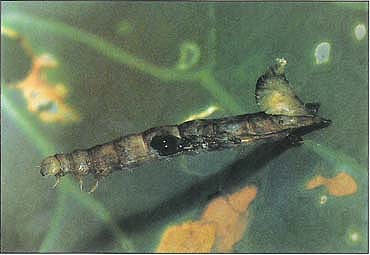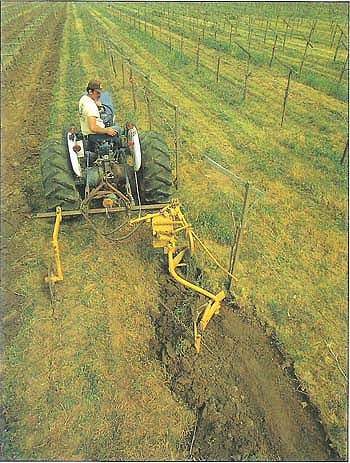All Issues
Integrated pest management in California
Publication Information
California Agriculture 44(5):4-6.
Published September 01, 1990
PDF | Citation | Permissions
Abstract
Agricultural pests include insects, nematodes, disease-causing organisms, mites, weeds, and vertebrates. By monitoring their populations and life stages, growers can act to control pests at the most effective times, before they can substantially damage crops.
Full text
Researcher Saskya Van Nouhuys monitors insect populations, in a strawberry field by beating a sample from the leaves. Workers will identify the insects' species later in the laboratory.
A naturally occurring Trichogramma spp. wasp lays her eggs within a tomato fruitworm egg. The wasps' parasitic larvae eliminate four-fifths of all tomato fruitworm eggs in California.
The development of synthetic pest control chemicals during World War II, in combination with improvements in chemical application technology, dramatically increased the potential for agricultural pest control. Pest control researchers, government agencies, and the agricultural industry overwhelmingly embraced the technology and set about perfecting it.
It did not take long before people began to see adverse effects from this new technology. Pests that had been naturally controlled by predators and parasites began to cause significant damage. They also became resistant to chemicals. Agricultural workers were reporting illnesses from exposure to pesticides.
As early as the 1950s, researchers at the University of California warned of the dangers of relying on a single pest control approach, and helped develop the philosophy of “integrated control” or “integrated pest management” (IPM). IPM is an ecologically based pest control strategy that considers all available management options, including inaction. IPM combines cultural, chemical, and biological controls with ecology and systems science.
It was not intuitively obvious that alternatives to the simple, effective approach of weekly or biweekly sprays prevalent in the 1950s and 1960s would be effective. The few pioneer crop consultants in California who first brought this kind of pest management knowledge and information to their grower clientele in the 1950s were the forerunners of today's crop consultants or pest control advisers (PCAs).
Increased IPM research in the 1970s accelerated the development of the consulting industry, and the need for crop consultants who could implement IPM systems became apparent. Extension IPM pilot projects for cotton and pears during this period demonstrated the value of the information that consultants could provide to growers. An IPM manual for pears, targeted at growers and their crop consultants, was produced as part of the pilot project. The need for properly trained professional crop consultants who would advise growers in IPM strategies was formally recognized in 1971, when California first required the licensing of pest control advisers.
Throughout the mid-1970s, individuals in state government, the University of California, and various agricultural interest groups called for increased development and awareness of IPM. Organized IPM research was conducted nationally and in California through federally supported programs such as the Adkisson and Huffaker projects. The California Department of Food and Agriculture's Environmental Assessment Team published a report in 1978 calling for, among other things, expanded research into alternative pest control strategies (specifically IPM), research on measures that would reduce pesticide hazards, and preparation of materials that would specify pest monitoring procedures, control actions and thresholds, pesticide hazards, and other management considerations. In his 1979 Environment Message, President Carter called for the development and adoption of IPM systems.
This cabbage looper was killed by a naturally occurring nuclear polyhidrosis virus. IPM researchers are looking at ways to use a granulosis virus for codling moth control. The viruses are harmless to humans, other mammals, and most beneficial insects.
Former UC Vice President for Agricultural and Natural Resources James B. Kendrick was a proponent of IPM research, and in 1978 he appointed Andrew Gutierrez of UC Berkeley to chair a special Advisory Committee for the Development and Implementation of a Statewide Integrated Pest Management Program in California. In 1979, the University of California Statewide IPM Project was approved as a special UC budget appropriation. Ivan Thomason was named project director and Andrew Gutierrez, associate director. Staff members were recruited during 1980, and research funds were first available that season. The goals of the IPM Project were fivefold:
-
to reduce the pesticide load in the environment
-
to increase the predictability, and thereby the effectiveness, of pest control techniques
-
to develop economically, environmentally, and socially acceptable pest control programs
-
to marshal agencies and disciplines into an integrated pest management program
-
to increase the utilization of natural pest controls
Major research and extension activities were initially limited to eight commodities-alfalfa, almonds, citrus, cotton, grapes, rice, tomatoes, and walnuts-and most program activities have focused on those crops. In 1987, under project director James Lyons, IPM workgroups that had emphasized specific commodities were restructured to emphasize several focus areas of IPM research, including biological control, cultural controls, commodity pest interactions, monitoring systems, and systems applications.
Over the past 10 years, the Statewide IPM Project has supported more than 200 research projects proposed by UC faculty at the Berkeley, Davis, and Riverside campuses and by Cooperative Extension staff. Much of the early research involved more fundamental studies about when and under what conditions organisms become pests. Researchers emphasized the development of simulation models to help them understand the relationships between crops and pests. Recent emphasis has shifted more to biological and cultural alternatives to pesticides. In 1990, the IPM project is sponsoring 52 projects in different commodity or urban situations. Of these, 17 are in biological control, 16 in cultural controls, 6 in monitoring systems, 7 in crop interactions, 4 in decision-making (expert) software, and 2 in social sciences.
A French plow or row plow helps control weeds and omnivorous leafrollers in vineyards without damaging vines or stakes. When the plow's trip lever contacts a stake or vine trunk, the plow blade moves back to pass around the obstruction.
The IPM Project employs a group of Area IPM Advisors who work in important agricultural production regions of California. They adapt and implement research-based IPM practices for use in the field. Their contacts are primarily with the Cooperative Extension Farm Advisors who work on commodities in their respective areas, and secondarily with the licensed PCAs who consult for growers. The IPM Advisors are linked with the Statewide IPM Project's research program and with its computer, education, and publications groups. This linkage helps keep implementation a major goal of the IPM Project and makes it unique among the IPM research programs in other states.
In 1988, the Statewide IPM Project began administering the federal USDA-Extension Service Smith-Lever IPM Project funds that support demonstrations, field days, and other extension activities intended to encourage growers and homeowners to adopt IPM practices. Twelve extension projects now receive these funds.
The IPM Education and Publications Group produces training programs and publications on pest management and pesticide safety. During the first five years of the IPM Project, the major emphasis was on developing IPM manuals for major agricultural crops. Recently, other important activities have been incorporated into the program: pest management guidelines, pesticide applicator training, PCA training, farm worker safety training, and development of books for gardeners, small farmers, and urban horticulturists.
Eleven IPM manuals have been produced since 1981. The books have received national recognition for their quality, style, excellent color photographs, and clear and cohesive presentation of IPM information for field use. Altogether, over 40,000 copies have been sold, and six manuals are in their second or third editions. The Pest Management Guidelines are related publications that contain brief suggestions for various pest controls, including pesticides, alternatives to pesticides, sampling and monitoring methods, treatment thresholds, and other IPM information. Camera-ready copies are sent to county Cooperative Extension offices for distribution, and are entered into the IPM Project's IMPACT computer for direct dial-up access. Subscriptions to the full set of guidelines are also available through UC ANR Publications.
In 1988, the IPM Project began coordinating training programs in IPM and pesticide safety. Eight UC pest management seminars for pest control advisers are held each year. The 1990 seminars, “Myths and Realities of Controlling Pests without Pesticides,” were attended by over 1,400 individuals. Continuing education seminars for pesticide applicators and structural pest control operators are also coordinated with counties and professional organizations each year. The IPM Project has printed the first volume of a Pesticide Application Compendium for pesticide applicators, and training videos are in production. Training videos, slide sets, and resource publications are being prepared in the important area of pesticide safety for farm workers.
The IPM computer system was created to provide research and extension staff up and down the state with tools that can improve their productivity and to transfer the models developed by researchers to county-based extension staff. The system includes common statistical tools and data entry utilities, weather data, and several types of models. The system's degree-day program has made it easy for many people to apply the important concept of temperature-regulated physiological development to many pest species.
The computer system has evolved into a central database and processing system accessible from virtually any terminal or microcomputer with a telephone modem. The user base includes all Division of Agriculture and Natural Resources staff and more than 300 agencies and private individuals.
Primary features for external users are the Pest Management Guidelines database, weather database, various degree-day and management models, and pest monitoring programs. Microcomputer applications include CALEX/Cotton, an expert system for cotton crop management, and DDU, a powerful degree-day utility. The weather database is the largest on-line collection of quality-controlled current and historic weather data available for California. Although it was developed primarily for research, it has become important to government agencies and pest management consultants as well.
During its first 10 years, the IPM Project has provided growers with many practical ways to reduce their reliance on pesticides. Several recent surveys show that growers and their crop consultants are adopting many of these practices. The following seven articles give a representative sample of the kind of work sponsored by the Statewide IPM Project.
Researchers tested six water regimes on rice and weeds grown in 36 basins. Half of them (right) were treated with herbicides, and half (left) were not. From the top of the photo, the first six plots are treatments 3,6,2,4,5, and 1.










